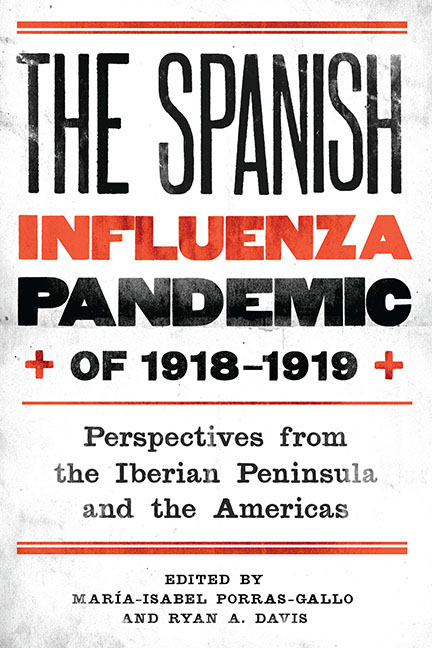 The Spanish Influenza Pandemic of 1918–1919
The Spanish Influenza Pandemic of 1918–1919 Book contents
- Frontmatter
- Dedication
- Contents
- Introduction: Emerging Perspectives of the Spanish Influenza Pandemic of 1918–19
- Part One Scientific Discourse: Now and Then
- Part Two Social Responses: Human and Institutional Actors
- 4 And to Make Things Worse, the Flu: The Spanish Influenza in a Revolutionary Portugal
- 5 Between the Pandemic and World War I: The 1918–19 Influenza Pandemic in the Spanish Army, through the Eyes of the Press
- 6 The Reign of the Spanish Flu: Impact and Responses to the 1918 Influenza Pandemic in Minas Gerais, Brazil
- 7 The Spanish Flu in Bahia, Brazil: Prophylaxis and Healing Practices
- 8 A Collaborative Experience: The Mutual Benefit Societies’ Responses to the 1918–19 Influenza Pandemic in Pamplona, Spain
- Part Three Interpreting the Epidemic: Sociocultural Dynamics and Perspectives
- Selected Bibliography
- List of Contributors
- Index
7 - The Spanish Flu in Bahia, Brazil: Prophylaxis and Healing Practices
from Part Two - Social Responses: Human and Institutional Actors
Published online by Cambridge University Press: 14 March 2018
- Frontmatter
- Dedication
- Contents
- Introduction: Emerging Perspectives of the Spanish Influenza Pandemic of 1918–19
- Part One Scientific Discourse: Now and Then
- Part Two Social Responses: Human and Institutional Actors
- 4 And to Make Things Worse, the Flu: The Spanish Influenza in a Revolutionary Portugal
- 5 Between the Pandemic and World War I: The 1918–19 Influenza Pandemic in the Spanish Army, through the Eyes of the Press
- 6 The Reign of the Spanish Flu: Impact and Responses to the 1918 Influenza Pandemic in Minas Gerais, Brazil
- 7 The Spanish Flu in Bahia, Brazil: Prophylaxis and Healing Practices
- 8 A Collaborative Experience: The Mutual Benefit Societies’ Responses to the 1918–19 Influenza Pandemic in Pamplona, Spain
- Part Three Interpreting the Epidemic: Sociocultural Dynamics and Perspectives
- Selected Bibliography
- List of Contributors
- Index
Summary
The Spanish flu was the biggest and most devastating disease of the twentieth century, infecting more than six hundred million people and killing between forty and one hundred million people worldwide in a short time span. The disease first occurred in the Northern Hemisphere in March 1918. It was spring, an unusual time for flu, but the low rate of mortality did not cause excessive concern among doctors and public health officials in the countries where the outbreak occurred. But the flu returned in August of the same year, this time in a much more virulent form, spreading to other parts of the world up until 1920.
It is difficult to specify the moment when the Spanish flu epidemic reached Salvador, the capital of the Brazilian state of Bahia, located on the country's eastern coast north of Rio de Janeiro. If we consider the intense movement in Salvador's port and its commercial connections with other countries, as well as the necessary time for the pathogen to infect individuals, spread through the city, and be noticed by the press and doctors, we can infer the disease was already in Bahia much earlier than mid-September, when the presence of an “unknown epidemic” was reported in the Bahian capital. But the press did not report the specific presence of the “Spanish Lady” in the city up until September 23, 1918, blaming her presence on the English packet steamer Demerara, which had moored with infected passengers in the port of Salvador on September 11. A report published later in Diario de Noticias stated that six deaths had occurred on the vessel while en route. Two of these deaths were people whose final destination was Salvador, though Bahia's Directorate General of Public Health was unaware of this and therefore failed to record them.
In this chapter we analyze how the disease infitrated the lives of Bahian- Salvadoran residents and its repercussions in the daily life of the city: the attitudes of the inhabitants in relation to the invasion of the disease and the threat of death, as well as their peaceful resistance to public health measures that went against cultural practices related to illness and death rites.
- Type
- Chapter
- Information
- The Spanish Influenza Pandemic of 1918–1919Perspectives from the Iberian Peninsula and the Americas, pp. 130 - 151Publisher: Boydell & BrewerPrint publication year: 2014


